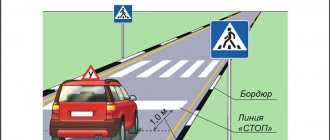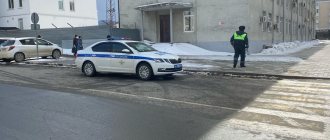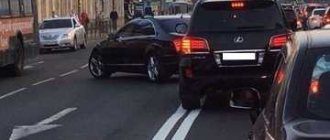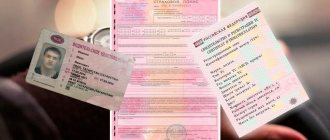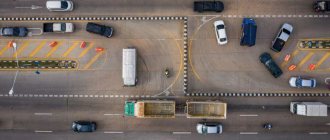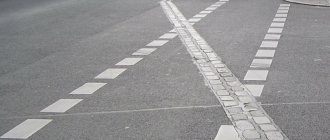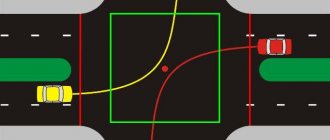What is a highway in Russia?
A highway, according to paragraph 1.2 of the Traffic Rules, is a special road with several carriageways for each direction, which are separated from each other by a road fence or dividing strip. At the same time, these roadways cannot have intersections at the same level with other highways, paths for cyclists or pedestrians, tram or railway tracks.
As can be seen from this official definition, any Russian highway cannot intersect with other roads at the same level, and at the same time it must necessarily have a dividing strip. The beginning of a route with special traffic conditions is indicated by sign 5.1 (it is called “Beginning of the Motorway”), the end by sign 5.2. Note that the highway may adjoin other roads at the same level if they are used to exit or enter it.
Such conditions reduce the risk of accidents, providing drivers with a more comfortable ride. Of course, special traffic rules have been developed for such highways, which stipulate all the nuances of traffic, including what the maximum and minimum speed on the highway can be.
Definition: unintentional stopping
Involuntary cessation of movement occurs in any of the following situations:
- the person sitting behind the wheel has experienced a sharp deterioration in their health – dizziness, nausea or painful sensations in the body;
- the passenger behaves inappropriately, insults the carrier, interferes with driving the vehicle;
- the object of transportation may create a dangerous situation;
- the car broke down or some technical problems appeared;
- some obstacle prevents you from continuing to move.
For example, a car tire may suddenly break, a tree may fall on the road due to a hurricane, or the asphalt may be damaged. The appearance of animals on the roadway will not be an exception.
The above situations will force the driver to brake forcibly.
It is worth understanding the difference between a regular and a forced stop. If a person needs to stop near a shopping center or store, this is a deliberate stop. The situation is similar if the driver is required to stop driving directly on the pedestrian path. Such a stop will still be normal, because there are no factors indicating a forced stop.
When a stop occurs in front of a pedestrian crossing, such a stop cannot be called unintentional, it is ordinary.
Thus, the person driving the vehicle follows the prescribed rules.
Please note that a forced stop is carried out even if it is contrary to traffic rules.
Speed limit on motorway
Paragraph 10.3 of the traffic rules states that the permitted maximum speed on the Russian highway within the city is 60 kilometers per hour, outside the city - 110 kilometers per hour. Since the end of the summer of 2013, permission for higher speeds (130 km/h) was introduced on a number of highways in the country. Moreover, such permission is approved exclusively by the owners of the highway. If the owners of the highway do not consider it necessary to introduce those same permissible 130 km/h, it will be possible to drive along it at the generally accepted 110 km/h and nothing more.
In addition, not all domestic highways, according to the rules, even have the theoretical opportunity to “acquire” a sign allowing vehicles to rush at a speed of 130 km/h. To install it, the highway should not have traffic lights, off-ramps, sharp turns and narrowings, or significant climbs, which are often the cause of accidents. Experts say that only some federal highways located in the central regions of the Russian Federation fully comply with the stated requirements in our country.
Another important point is that the minimum permissible speed on the highway is not specified. But those vehicles that, due to their technical condition and capabilities, are not capable of reaching speeds of more than 40 kilometers per hour, are not allowed on “fast” roads. This does not mean that drivers are required to drive at a speed of 40 km/h or less. It is also possible to drive on the highway at a snail's pace (30–35 km/h), the main thing is that the car can increase its speed if necessary.
Comparative characteristics
When we are talking about a deliberate cessation of traffic for a short period of time, while passengers are being transported or cargo is being handled, we can talk about such a maneuver as stopping.
Parking is a cessation of traffic that is not associated with passenger transportation or cargo, which takes more than 5 minutes. For example, if a car stops near a clinic to drop off a person, this is a stop. When a vehicle is parked for an hour or more, it is already a parking lot.
It is interesting that even the longest process is called a stop, the main thing is that it is associated with passengers or unloading or loading of goods.
A stop is also a short-term cessation of movement for less than five minutes, it does not even matter the type of activity of the driver or his passengers.
There are certain rules regarding stopping and parking a vehicle:
- On the right side of the road you can park your car on the side of the road. It is important that if the side of the road is occupied by some objects or other cars, you should not park your car on the roadway;
- it happens that there is no shoulder, then the car is allowed to be parked along the edge of the roadway;
- the last option allowed was the sidewalk.
It is usually customary to stop on the right side of the road, but exceptions have been made, so stopping on the left side is also allowed.
It is important that such delays are strictly permitted in cities, towns, and villages. This is possible when the road is two-lane and there are no tram lines in the center. You can stop on the left side of the road when there is one-way traffic. In such a situation, the presence of tram tracks does not matter.
Interestingly, parking and deliberate interruption of traffic for the purpose of disembarking passengers are not allowed for freight transport. Only stopping to load or unload goods is permitted.
Controversial situations and ways to avoid punishment
If the driver stops on the highway without reaching a special stopping place, he must turn on the hazard warning lights and display an emergency stop sign (what is the fine for not having a warning triangle?). This way, in most cases, it is possible to avoid a fine for stopping in the wrong place.
Although slow-moving vehicles are prohibited on highways, you can drive on the road at a speed not exceeding 40 km/h. But such a speed can lead to an accident, since the driver of a fast-moving car may simply not notice you (what are the fines for speeding?). However, there is no penalty for driving at low speeds.
Fine for turning around on a motorway through a technological passage
As for the fine, here it is necessary to refer to the Code of Administrative Offenses of the Russian Federation. We are interested in article 12.11, part 3. I quote.
Turning or driving a vehicle into technological gaps in the dividing strip on a highway or driving in reverse on a highway - entails an administrative fine of 2,500 rubles.
That is, if you have a desire to turn around where you want on the highway, and not where you can, then know that it may cost you a tank of gas, and maybe it’s still worth driving a few more kilometers, but do everything according to the rules, and most importantly the main thing is to be safe!
Punishment for failure to comply with highway rules
Compliance with the rules of movement on the highway will save the driver from many troubles. In addition to creating emergency situations, violations are punishable by serious fines:
- when driving a training vehicle or violating the position of the truck on the road - 1 thousand rubles;
- performing maneuvers with a U-turn in a highway area, using reverse gear – 2.5 thousand rubles;
- occupying the left carriageway if there is sufficient space on the right - 1.5 thousand rubles.
Video about driving on the motorway
By observing increased safety measures and paying special attention to the situation on the road, the motorist will be able to appreciate the benefits of high-speed driving without any damage to his wallet, reducing the risk of an accident on the road.
Possible fines
The amount of the fine for driving in reverse varies depending on the degree of danger of the maneuver.
- When driving in the opposite direction on a one-way road, the amount is 5,000 rubles. If the maneuver created a particular threat to others, the court may even take away the rights for a period of 4-6 months.
- Driving on the highway risks losing 2,500 rubles.
- If the owner of a vehicle commits an offense while driving along the side of the road or dividing strip, he will be fined 1,500 rubles.
- The driver of a car who backs up in a dedicated lane for minibuses will face a penalty of 1,500 rubles (a fine twice as large is imposed in Moscow and St. Petersburg).
- Entering under a “brick” is punishable by a fine of 500 rubles.
A responsible motorist must not only know all the situations when he has no right to reverse, but also remember the measures that should be taken to ensure the safety of the maneuver.
Driver actions on the highway
The basic rule of behavior on the motorway is to keep to the right on the road. This rule will allow other traffic participants in the same direction to safely maneuver using the left carriageway. This rule is established both when driving around the city and outside its boundaries, and non-compliance entails a fine.
U-turn on the highway
Carrying out maneuvers at high speeds on the highway requires the driver to be extremely careful and vigilant. You won't be able to turn around on the expressway - you need to use special road junctions. It is strictly unacceptable to use the dividing strip for turning, even if it is marked only by road markings and has technological gaps. Any trip into a technological gap entails a fairly serious fine.
Reversing
As soon as a motorist has entered the highway, other traffic rules begin to apply, which do not allow driving in the opposite direction under any circumstances. Reversing on a motorway can cause a serious accident and is therefore prohibited. Violation is also punishable by a serious fine.
If a stop is required, the driver looks for special places equipped with “Rest Place” or parking signs.
There are situations when the car cannot move due to a breakdown, in which case it is a forced stop, requiring the activation of emergency signals and the installation of an emergency sign. The driver of a faulty vehicle must take measures to move it beyond the boundaries of the continuous road. The farther away the warning triangle is placed, the less danger drivers face.
Training driving and cargo transport
The highway is not the place to improve your driving skills. Since high speeds develop on the road, the training vehicle cannot be used, and in case of violation, a fine is issued.
The restrictions also affected freight transport - if the car belongs to category “C”, it is not allowed to move beyond the second lane.
